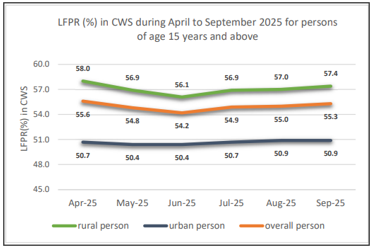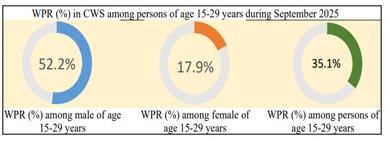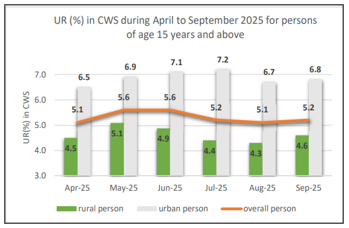SYLLABUS
GS-3: Indian Economy and issues relating to planning, mobilization, of resources, growth, development and employment.
Context: The National Statistical Office (NSO), released the Periodic Labour Force Survey (PLFS) Monthly Bulletin for September 2025 to provide monthly estimates of employment and unemployment indicators across India.
More on the News
- The September 2025 PLFS bulletin marks the sixth monthly release under the revamped survey design initiated in January 2025.
- This redesigned PLFS follows a rotational panel sampling method, where each selected household is surveyed four times over four consecutive months to generate reliable monthly and quarterly labour market estimates.
- The report shows a consistent rise in labour force participation, especially among rural women, which has strengthened overall female workforce participation for the third consecutive month.
- The overall Labour Force Participation Rate (LFPR) has reached a five-month high, while the Worker Population Ratio (WPR) also shows the highest level since May 2025.
- A slight uptick in the Unemployment Rate (UR) was observed in September 2025, mainly due to increases in both rural and urban unemployment among men and women.
- The findings indicate that India’s rural economy is absorbing more female workers, reflecting a broader trend of economic inclusion and resilience in rural labour markets.
Key Highlights of the Survey
Labour Force Participation Rate (LFPR)

- The LFPR represents the proportion of the population (aged 15 years and above) that is either employed or actively seeking employment. It measures the active participation of the working-age population in the labour market.
- The overall LFPR increased to 55.3% in September 2025, marking a continued upward trend for the third consecutive month.
- The LFPR in rural areas rose from 56.1% in June 2025 to 57.4% in September 2025, reflecting stronger participation in agricultural and non-farm activities.
- The LFPR in urban areas remained steady at 50.9%.
- The female LFPR, driven by rural participation, reached 34.1%, the highest since May 2025. Rural female LFPR increased from 35.2% in June 2025 to 37.9% in September 2025, showing consistent month-on-month growth.
Worker Population Ratio (WPR)

- The WPR indicates the proportion of the working-age population that is employed, reflecting the actual extent of employment among those aged 15 years and above.
- The overall WPR stood at 52.4%, the highest level since May 2025.
- Rural WPR rose to 54.8%, while urban WPR was 47.4%, showing a higher employment intensity in rural areas.
- The increase in overall WPR was mainly driven by the steady growth of the female workforce in rural India.
- Rural female WPR improved from 33.6% in June 2025 to 36.3% in September 2025, marking three consecutive months of increase.
Unemployment Rate (UR)

- The UR measures the proportion of the labour force that is unemployed but actively seeking or available for work. It reflects the demand-supply balance in the labour market.
- The overall UR increased slightly to 5.2% in September 2025 from 5.1% in August 2025.
- The UR in rural areas rose to 4.6%, while in urban areas it reached 6.8%.
- Among urban females, unemployment increased to 9.3% from 8.9% in August 2025, indicating continued challenges in female urban employment.
- Male unemployment rates also increased moderately in both rural (4.7%) and urban (6.0%) regions after a temporary decline in August 2025.
Significance of the Report
- This report reflects India’s post-pandemic labour market recovery and the strengthening of rural economic activities.
- The steady rise in rural female participation highlights improving gender inclusion in productive work and economic empowerment in rural areas.
- Monthly estimates enable timely monitoring of employment trends, supporting evidence-based policy formulation and targeted job creation initiatives.
- The PLFS monthly series enhances the accuracy and responsiveness of labour statistics, helping align national employment policies with broader goals of inclusive and sustainable economic growth.

